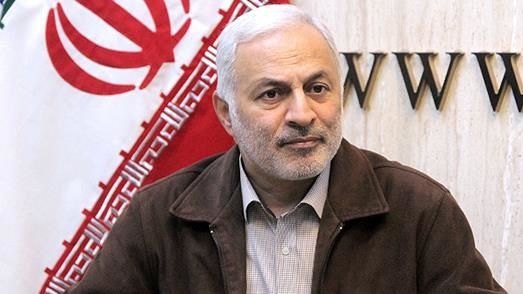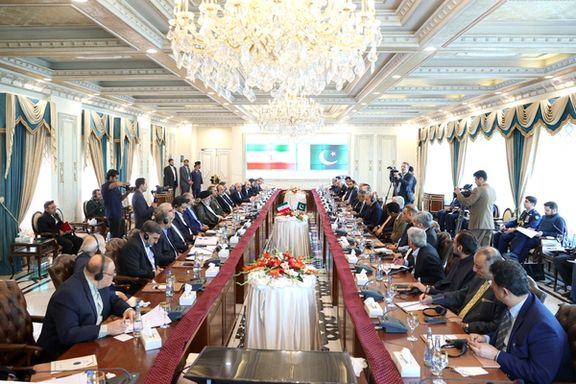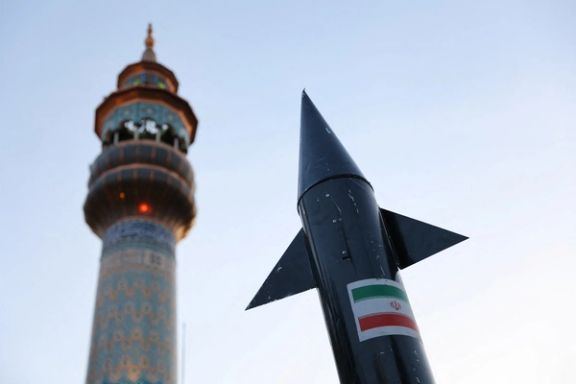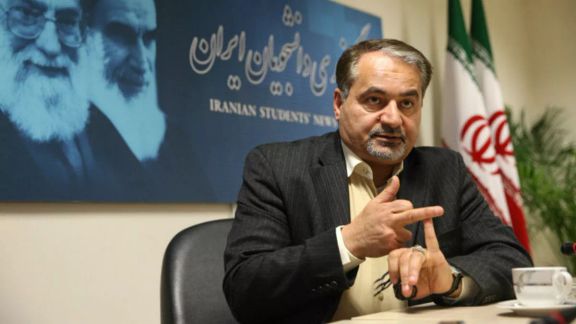Israeli Airstrikes In Southern Lebanon Kill Two Senior Hezbollah Militants

Israeli airstrikes in southern Lebanon have killed two high-ranking members of Iran-backed Hezbollah militant group.

Israeli airstrikes in southern Lebanon have killed two high-ranking members of Iran-backed Hezbollah militant group.

Vahid Jalalzadeh, the head of Iran's National Security and Foreign Policy Commission, has criticized Jordan's recent role in intercepting Iranian drones destined for Israel.
The incident, which took place on April 13, saw Jordan's air force joining a US-led coalition downing Iranian drones that violated its airspace, part of an aerial bombardment of over 350 drones and missiles aimed at Israel.
Jalalzadeh argued that Jordan must be held accountable for its actions, which he views as antagonistic toward Iranian interests.
In a covert threat to Israel's allies, he also warned that If Israel utilizes facilities from regional countries and American bases against Iran, there will be a military response. Jordan was among multiple nations including the US, UK and France, involved alongside Israel in defending itself from the unprecedented air assault.
Iran claimed the barrage was in response to an alleged Israeli air strike at the start of the month in which a senior Quds Force commander was assassinated and multiple other high ranking members of the IRGC were killed.
According to a statement from the Jordanian cabinet the day following the incident, Jordan intercepted several airborne objects that had entered its airspace to safeguard the safety of its citizens. “Some shrapnel fell in multiple places during that time without causing any significant damage or any injuries to citizens,” it added.
Jordan, which borders Iranian proxy strongholds Syria and Iraq, increased its defensive measures by requesting the deployment of Patriot air defense systems from the US last year.
The latest developments come amid reports of increased US military aid to Jordan, which hosts hundreds of American troops conducting regular exercises with the Jordanian army.

Belgian MP of Iranian descent Darya Safai announced the country’s government supports her proposal to designate Iran's Islamic Revolutionary Guard Corps (IRGC) as a terrorist organization within the EU.
Safai revealed that she submitted a resolution more than a year ago, emphasizing her persistent efforts to highlight the IRGC's activities.
"For a long time now, I have been making great efforts to convince everyone, and certainly the Belgian government, that the IRGC is a terrorist organization that belongs on the terror list," Safai wrote on social media platform X.
Belgium’s Foreign Minister, Hadja Lahbib, voiced support for the initiative on Monday. Speaking to journalists in Luxembourg ahead of an EU ministers’ meeting, Lahbib acknowledged that while there is no consensus yet on the legal basis for such a designation, the new sanctions against Iran in response to the country’s recent attack on Israel should include the Islamic Revolutionary Guard Corps.
The European Union has decided to enhance sanctions against Iran following Tehran's recent attack on Israel, a decision reached after a meeting of the bloc's foreign ministers. During a press conference in Luxembourg on Monday,
EU foreign policy chief Josep Borrell announced that the new sanctions would target Iran's missile production and expand the list of banned drone-related components. The additional measures aim to augment the existing sanctions, which were initially imposed due to Iran's role in supplying drones to Russia for its military actions in Ukraine.

Iranian President Ebrahim Raisi met Pakistan's army chief, Syed Asim Munir, during a three-day visit to Pakistan as the two countries aim to deepen ties after a year marked by conflict.
Tensions escalated three months ago when Pakistan conducted airstrikes in southeastern Iran following attacks by Iran’s Revolutionary Guards within Pakistani territory. Both countries stated that their strikes aimed at "terrorist hideouts", both ended up with civilian deaths including women and children.
Iran claimed its operations targeted bases of the Sunni militant group Jaish al-Adl, while Pakistan said its attacks were directed at insurgents generally referred to as "Sarmachar."
During his visit, Raisi also held discussions with Pakistani Prime Minister Shehbaz Sharif. The two countries restored diplomatic relations in January after the border clashes had seen ambassadors recalled for a short period. In January, a joint naval exercise was held by the two nations off the coast of Bandar Abbas, involving combat vessels and missile-launching warships.
The relationship between Pakistan and Iran has been complex. Iran sees Pakistan as influenced by Islamabad's historically closer ties to Saudi Arabia and the United States.
Earlier this year, the US blocked a planned gas line project revival between Pakistan and Iran, warning it would result in more US sanctions. It has been on hold for over a decade.

Around 4 am on April 19, Isfahan province was jolted by three powerful explosions. Israel's missiles had reached far into Iranian territory, a mere six days after Tehran's own drone and missile attack on Israel.
Despite the clear evidence of the strike, the Islamic Republic persisted in its state of denial.

What Does Israel's Strike Reveal About Iran's Air Defence System?
According to US sources, three missiles were launched towards Isfahan’s Eighth Shekari Air Base from outside Iran's airspace, breaching its air defense shield. The strike, as shown by satellite imagery, caused damage to the engagement radar, a crucial component of Iran's S-300 air defense systems. The S-300 is a family of Russian-made surface-to-air missile (SAM) systems.

Just a day or two before the attack, media affiliated with the Islamic Republic boasted about Iran's air defense system's capability and readiness to confront Israeli fighter jets and precision missiles by publishing images of Iranian made air defense systems. In recent years, Iran has undergone a notable evolution in its air defense capabilities. As of the end of 2023, Iran boasts the development of 21 indigenous mobile air defense systems. These systems offer comprehensive coverage, spanning from low to high-altitude surveillance air defense systems.

Among these layers stands the Bavar-373 (Belief) long-range air defense system, claimed to surpass both the Russian S-300 and U.S. Patriot systems. The Islamic Republic boldly asserts that the Bavar-373 possesses the capability to detect and engage high-altitude and stealth aircraft, helicopters, drones, as well as anti-radiation, ballistic, and cruise missiles. Similar to the S-300, the Bavar-373 includes a command vehicle, search radar, engagement radar, and up to six launchers.


In 2016, Iran acquired four S-300 battalions from Russia, predating the introduction of the Bavar 373 in 2019. Allegedly, half of one of S-300 battalions is annually redeployed to Mashhad to safeguard Iran's Supreme Leader, Ali Khamenei. Yet, with the presence of the S-300 in Isfahan's airbase, targeted by Israeli missile strikes, and the periodic relocation of part of the S-300 battalion to Mashhad during Khamenei's annual visits to the city, one might question Iran's professed confidence in its indigenous air defense.
Underestimation: A Risky Gambit
The precision strike executed by Israeli fighter jets, coupled with the dismantling of the radar engagement system in Iran's S-300 air defense network, starkly exposes the vulnerabilities within Iran's aerial shield. US military sources suggest that the strike was intended to demonstrate Israel's ability to penetrate Iran's defensive systems unnoticed. However, one should not underestimate Iran's determined efforts to bolster and expand its air defense capabilities.
On June 20, 2019, Iranian forces downed a US military surveillance drone flying over the strategic Strait of Hormuz. The Khordad 3 anti-aircraft system was hailed as the hunter.


Some military analysts argue that Israeli long-range missiles were fired from Iraq's airspace onto an airbase in Isfahan. Iran's bold move of arming so called ‘Axis of Resistance’ group has already set the stage for chaos. If the Islamic Republic succeeds in deploying air defense systems to its regional proxies, establishing a defensive stronghold in Lebanon, Syria, Iraq, and even Yemen, it would create an air defense axis, presenting a significant challenge to the aerial supremacy of Israeli forces and their allies, which were one of the key factors in Israel's success in intercepting 99% of Iran's projectiles on April 12. This journey is well underway, as evidenced by the shootdown of an American MQ-9 Reaper drone, by Iran-backed Houthi forces in Yemen on November 8,2023 . Farzin Nadimi, a Senior Fellow with The Washington Institute, attribute the likely use of Iranian-made "Item 358" air defense cruise missiles in the attack.

Expanding its arsenal beyond the existing 21 mobile air defense systems, the Islamic Republic introduced two additional defense systems: The Arman anti-ballistic missile system and the Azarakhsh low-altitude air defense system. Unveiled by the Ministry of Defence on February 19, these additions underscore Iran's ongoing efforts to enhance its aerial defense capabilities.
Disregarding the satellite images that prove the accuracy of Israeli military tech, the country’s Supreme Leader, Ali Khamenei, brushes off the low success rate of the Islamic Republic's missile launches as “secondary issue”.
What was scarcely mentioned in his meeting with high-ranking military commanders on Sunday was his emphasis on innovation in armaments. He remarked: "We mustn't pause for a moment, as stagnation implies regression. Therefore, innovation in armaments and tactics, along with a thorough understanding of the enemy's strategies, should always remain a priority."
The directive from the Leader of the Islamic Republic is crystal clear: the enhancement of Iran's air defense system extends beyond national borders to include its proxy forces.

In assessing the statements of analysts and commentators about Iran’s foreign policy and human rights record, it is essential to be aware of their relationship with the government in Tehran.
In his latest article, "Iran-Israel tensions: Only a grand bargain in the Middle East can avert regional war," published on April 18, 2024, Seyed Hossein Mousavian once again casts the United States, Israel and NATO as the principal antagonists in the Middle East's ongoing turmoil, conveniently omitting the destructive roles played by Iran's own regime.
Mousavian's narrative fails to acknowledge how Iran’s Islamic regime has fueled regional instability by supporting and arming terrorist organizations such as Hezbollah, Hamas, and the Houthis. These groups have been pivotal in executing Iran's agenda, spreading violence and discord across the region.
Mousavian’s call for the West to engage in appeasement and offer incentives to Iran is a repetitive strategy that surfaces whenever the Islamic Republic faces international pressure or isolation. His articles typically push for a conciliatory approach towards Iran, advocating for unwarranted concessions without addressing the fundamental issues of Iran's sponsorship of terrorism and its blatant disregard for international norms. This biased viewpoint not only misrepresents the true dynamics of Middle Eastern conflicts but also undermines the pursuit of genuine peace and stability in the region.
No wonder that Iranian government-controlled media in Tehran extensively covered Mousavian’s article as a major development, showing the way forward for “peace in the region.”

In discussing Iran-Europe relations, Mousavian paints a rosy picture of the diplomatic ties between Iran and Germany during the tenure of Germany's Chancellor Helmut Kohl and Iran's President Ali Akbar Hashemi Rafsanjani. Mousavian highlights the political, cultural, and economic collaboration fostered between the two nations, emphasizing Germany's opposition to US sanctions and their support for Iran through banking and insurance credits, which aided Iran's post-war reconstruction after Iraq's invasion. However, Mousavian's account conspicuously omits a critical aspect of the Iran-Germany relationship during this period: the assassination of Iranian dissidents on European soil, most notably the Mykonos restaurant attack.
The Mykonos restaurant in Berlin was the site of a brutal attack in 1992, where four Iranian-Kurdish dissidents were murdered. This attack was not an isolated incident but part of a broader strategy by the Iranian regime to silence opposition, even beyond its borders. The assailants were linked to the Iranian government, leading to a notorious trial that profoundly impacted Iran's international relations. The Berlin Court's ruling in the Mykonos trial explicitly named the Iranian government as responsible for the assassination, stating that the orders had come from the highest levels of leadership in Tehran.
Mousavian's narrative fails to address how Iran's actions in Europe, including the Mykonos attack, severely damaged its diplomatic relationships. The trial and its aftermath demonstrated Iran's willingness to conduct state-sponsored terrorism on foreign soil, fundamentally breaching international law and the norms of diplomatic engagement. The verdict was a landmark moment, as it was one of the first times a European court directly accused the Iranian government of such grave actions, leading to a diplomatic fallout between Iran and Germany. This fallout was not, as Mousavian suggests, due to US pressure or unwillingness to normalize relations but was a direct response to Iran's aggressive and unlawful actions in Europe.
The documentary "Holy War," by Reza Allamezadeh for Dutch television in 1994, delves into this tense period before the Mykonos trial verdict in 1997. The film highlighted how the Iranian embassy, led by Mousavian at the time, attempted to suppress its broadcast. Upon realizing Allamezadeh’s involvement, the embassy tried to buy the film to prevent its airing. It resorted to veiled threats against the filmmaker and his family when their initial attempts failed. The documentary ultimately aired, drawing significant viewership, and contributing to the public discourse on Iran's covert operations in Europe. This incident exemplifies how Iran, under the guise of diplomatic relations, misused its ties with Germany, assuming that solid bilateral relations would shield it from the repercussions of its illicit actions abroad.
In the documentary Holy War, Mousavian makes several statements (Minute 33:44) that starkly contrast with the historical actions and policies of the Islamic Republic of Iran. Mousavian asserts that Iran does not carry out executions without trials, claiming such actions would violate the Iranian constitution. He also suggests that the Iranian government is firmly against terrorism in any form and eagerly awaits the judicial outcome of the Berlin Mykonos trial, confident of Iran’s non-interference in the assassinations of Iranian Kurds in Germany.
These statements, however, stand in direct contradiction to well-documented records of the regime's conduct since the Islamists came to power in 1979. Research and historical data, including those from the Rastyad, paint a grim picture of systemic human rights abuses. For instance, in 1981 alone, more than 3,200 people were executed in Tehran, including 104 children. Furthermore, during the summer of 1988, Iran witnessed the mass execution of over 5,000 political prisoners. These individuals, already serving prison sentences issued by kangaroo courts, were summarily executed without any new crimes being committed, clearly indicating executions without fair trials.
Mousavian's comments in the film not only whitewash these atrocities but also misrepresent the constitutional and judicial realities of Iran. His claims are particularly egregious given the evidence of Iran’s routine use of extrajudicial killings and its blatant disregard for both domestic and international legal standards. Mousavian's demeanor and assertions in the documentary could be seen as an attempt to reshape public perception and mitigate the international fallout of the Mykonos trial. His narrative is disingenuous and serves as a stark reminder of the lengths to which officials of the Islamic Republic will go to fabricate state innocence and manipulate historical facts to their favor.
This series of events underscores the complexities of international diplomacy and highlights the substantial barriers to normalization with Europe due to Iran's involvement in acts of terror. Mousavian's selective recounting and blame on external forces like the United States distort the actual dynamics, overlooking how Iran's actions have significantly impacted its foreign relations and led to diplomatic isolation. The story of the "Holy War" and the Mykonos trial encapsulates the challenges and the urgent need for accountability in dealing with state-sponsored terrorism, reinforcing the necessity for a truthful, comprehensive dialogue about Iran's international conduct.
It is disheartening to see that Princeton University, a prestigious academic institution, has employed Seyed Hossein Mousavian—a former Iranian government official whose professional history is marred by affiliations with state-sponsored cross-border political violence and blatant disregard for human rights. As family members of the victims of the Islamic Republic's atrocities, we demand that Princeton take immediate action to terminate Mousavian's association with the university. Despite our detailed letter to the President of Princeton University outlining our concerns and demands, our pleas have been ignored. In response, we will gather in front of Princeton University on April 26 to remind the public and the university community that they host an individual who not only poses a grave threat to the safety of Iranians and Americans alike but also undermines the ethical standards and integrity expected of such an esteemed institution. This protest aims to shed light on the administration's baffling decision to protect a known perpetrator of human rights abuses, calling for accountability and the immediate dismissal of Mousavian.
The opinions expressed by the author are not necessarily the views of Iran International
A video released by the Israeli army on Tuesday showed a strike on a car driving in Aadloun in southern Lebanon, which the army said killed a "significant operative in the Hezbollah's aerial defence unit."
Hezbollah confirmed the death of one of its fighters, Hussein Azqul (Azkoul). Israel describes hims as “central terrorist” in Hezbollah’s air defense unit while sources close to the group said he was an engineer in Hezbollah's aerial defence units and that he had been active in Hezbollah's field operations.
Azqul, according to the IDF, was “heavily involved in the activities of the [air defense unit] and took part in the planning and execution of a variety of terror activities.”
A separate Israeli strike overnight Monday (April 22) to Tuesday killed Muhammad Attiya, a member of the aerial unit of Hezbollah's elite Radwan Forces, the IDF said.
Hours after the strike, Israel intercepted several drones over its northern coast. Drone infiltration sirens were triggered in Nahariya, Acre, and other northern areas, with the IDF neutralizing three drones believed to be carrying explosives.
The ongoing skirmishes have led to the evacuation of approximately 70,000 residents from northern Israeli communities amid daily attacks from Hezbollah and other Iran-backed forces.
Last week, the Israeli military confirmed the death of a senior Hezbollah commander, Ismail Yousef Baz, in an airstrike. According to IDF reports, Baz was involved in orchestrating and executing rocket and anti-tank missile attacks against Israel from Lebanon's coastal regions.
Hezbollah, supported by Iran and allied with groups such as Hamas and Palestinian Islamic Jihad, has escalated its aggressive actions against Israel.






